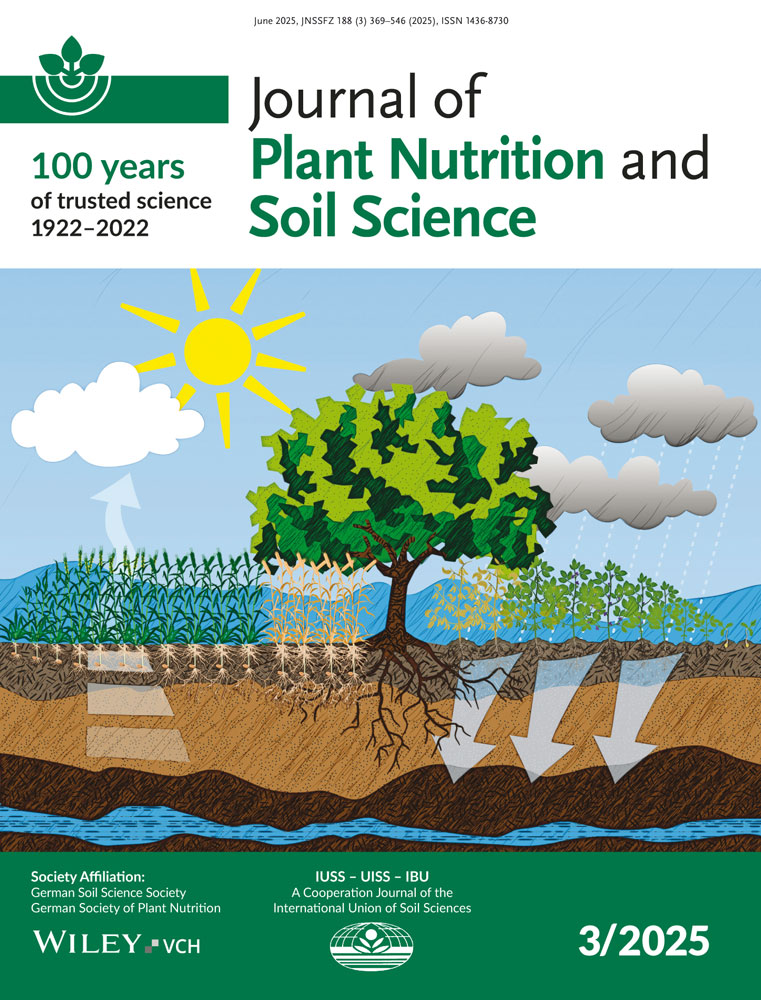Exchangeability of phosphate extracted by four chemical methods†
This paper is based on the PhD thesis that the first author is completing in the Institute of Plant Sciences of the Swiss Federal Institute of Technology, Zurich (ETHZ).
Abstract
enIsotopically exchangeable phosphate (P) is a major source of P for plants. In practice, however, plant-available P is assessed by chemical extractions solubilizing a mixture of P forms the availability of which is ill defined. We undertook an isotopic approach to assess the exchangeability of P extracted by (1) CO2-saturated water (P-CO2), (2) ammonium acetate EDTA (P-AAEDTA), and (3) sodium bicarbonate (P-NaHCO3) compared to the exchangeability of P extracted by water. Five topsoils with similar P-fertilization histories but different soil properties were studied. Phosphorus was extracted from soils labeled with carrier-free 33P after 1 week of incubation, and the specific activity (SA = 33P / 31P) of the extracts was compared with the SA of P extracted by water to calculate the amount of P isotopically exchangeable that had been solubilized during the extraction. P-CO2 extracted between 20 and 100 times less P than P-AAEDTA and P-NaHCO3. The SA of P-CO2 was not different from the SA of water-extractable P, showing that P-CO2 solubilized similar forms of P as water and that these forms can be considered as available. The SA of P extracted by the two other methods ranged between 25% and 63% for P-AAEDTA and 66% and 92% for P-NaHCO3 of the SA of water-extractable P. The fraction of exchangeable P extracted by AAEDTA decreased linearly with increasing soil pH, suggesting that this method dissolves slowly or non-exchangeable P from calcium phosphates.
Abstract
dePhosphataustauschbarkeit, bestimmt mittels vier chemischer Extraktionsmethoden
Isotopisch austauschbares Phosphat (P) ist eine der Haupt-P-Quellen für Pflanzen. In der Praxis wird pflanzenverfügbares P mittels chemischer Extraktionen ermittelt. Dabei werden unterschiedliche P-Formen extrahiert, deren Verfügbarkeit nur ungenügend definiert ist. Mittels der Isotopentechnik verglichen wir die Austauschbarkeit von P, das extrahiert wurde durch 1) CO2-gesättigtes Wasser (P-CO2), 2) Ammoniumacetat EDTA (P-AAEDTA) und 3) Natrium-Bicarbonat (P-NaHCO3), mit der Austauschbarkeit von mit Wasser extrahiertem P. Dabei wurden fünf Oberböden mit gleicher P-Düngung, aber unterschiedlichen Bodeneigenschaften untersucht. Die Böden wurden während einer Inkubationszeit von einer Woche mit 31P-trägerfreiem 33P markiert. Um die Menge an isotopisch austauschbarem P, welches während der Extraktion aus dem Boden gelöst wurde, zu bestimmen, wurde die spezifische Aktivität (SA = 33P / 31P) der Extrakte mit der SA von P, das mit Wasser extrahiert wurde, verglichen. Die Extraktion mit CO2-gesättigtem Wasser setzte 20- bis 100mal weniger P frei als diejenige mit AAEDTA oder NaHCO3. Die SA von P-CO2 unterschied sich nicht von derjenigen von mit Wasser extrahierbarem P. Das weist was darauf hin, dass mit P-CO2 dieselben P-Formen gelöst werden wie mit Wasser; diese P-Formen können als pflanzenverfügbar angesehen werden. Die SA von P, das mit AAEDTA bzw. NaHCO3 extrahiert wurde, machte 25–64% bzw. 66–92% der SA von mit Wasser extrahierbarem P aus. Die mit AAEDTA extrahierte austauschbare P-Fraktion nahm linear mit ansteigendem Boden-pH ab, was darauf hindeutet, dass mit dieser Methode langsam oder nicht austauschbares P aus Calcium-Phosphaten gelöst werden kann.




